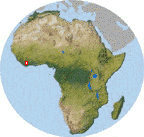

The following information is primarily from Boesch & Boesch (1983, 1984, 1989):
Taï National Park is located in the Ivory coast and covers an area of approximately 4260 km2. The study site is located in the western part of the park, 30km east of the nearest city, Taï , and the Liberian border. In 1983 this region of the park was efficiently protected against logging companies. Human predation was low, except on elephants; and the native tribes, the Gueres and Oubis, did not eat chimpanzees. In 1991 an increase in leopard predation caused a decrease in the community, and in 1995 the community also fell victim to outbreaks of the Ebola virus.
The study area is predominantly flat, with numerous streams bordered by specific flora, whereas the rest of the forest is quite homogeneous. The forest is of the Eremospatha macrocarpa and Diospyros manii type. The climate is characterized by two rainy seasons (March-June and Sept - October) and two dry seasons (July- Aug and Nov-Feb.) and averages1800mm rainfall per year. The temperature varies between 24-28°C.
Since September 1979 the chimps at Taï have been studied with support from the Swiss National Science Foundation. Results obtained from the first studies were on on tool-use and hunting behavior. The community size was originally approximately 80 with a home range of 27km2. Due to the limited visibility in the forest, at most 20m on ground, habituation was slow. After 2.5 years researchers could observe chimps that were aware of their presence. After 4 years, 8000 field hours yielded only 440 hours of actual observation. Then from March, 1984 onwards, they could follow all males by sight and remain remain in the group during daily activites (hunting, foraging). At present there are three habituated neighboring communities, North, Middle and South.
A second research site at Taï is under the direction of Ronald Noe; research here focusses on several species of monkey. For more information on the Taï Monkey Project see http://www.mpi-seewiesen.mpg.de/~knauer/colobe.html.
Primary source for the following Site Data is McGrew et. al. (1996), Great Ape Societies (Cambridge University Press), Appendix.
| Name: | Taï |
| Location: | Ivory Coast, Sous Prefecture de Taï , 5° 52'N, 7° 20'W |
| Status: | National Park |
| Area: | 30km2 in 4260km2 |
| Altitude: | 160-245m |
| Temperature: | 24-28°C |
| Rainfall: | 1829mm, range 1505-2150mm (1988-1993) |
| Vegetation: | Evergreen moist rainforest |
|
Human influence: |
Rare selective logging until 1975, some poaching, no
provisioning Disturbance ratings -- 1, 1, 2, 2, 1 |
|
Closest village: | 9km, some fields 5km away |
|
Species studied: | Pan troglodytes verus (3 communities) |
|
Population Density: |
2.9 per km2(1986) 1.7 per km2(1989-90) |
| Fauna: | Click for list, mostly mammals |
|
Study period: | 1976, 1979-present |
| Habituation: | Excellent |
|
Research presence: | Permanent |
| Conservation: | WWF and GTZ integrated conservation projects |
|
Current research: | Social organization, cooperation, food sharing, hunting, tool use, cultural variation, ontogeny, feeding ecology |
| Methods: | Focal-subject sampling, nest-to-nest |
|
Contact person: |
Chimpanzee research: Christophe Boesch, Max Planck Institute
for Evolutionary Anthropology,
Department of Primatology,
Inselstrasse 22,
04103 Leipzig, Germany
Tai Monkey Project: Ronald Noe, Laboratoire d'Ethologie et Neurobiologie, URA 1295, Universite Louis Pasteur, 7 rue de l'Universite, F - 67000 Strasbourg, France, [tel. office: (+33/0) 388 358 249, fax office: (+33/0) 388 358 449] Ronald.Noe@wanadoo.fr |
| Habitat photos: | --- |
| Maps: | --- |
| Aerial photos | --- |
| Miscellaneous: | Related links |
| Bibliography: | Contains works cited in the creation of this page and other related references to Taï . |